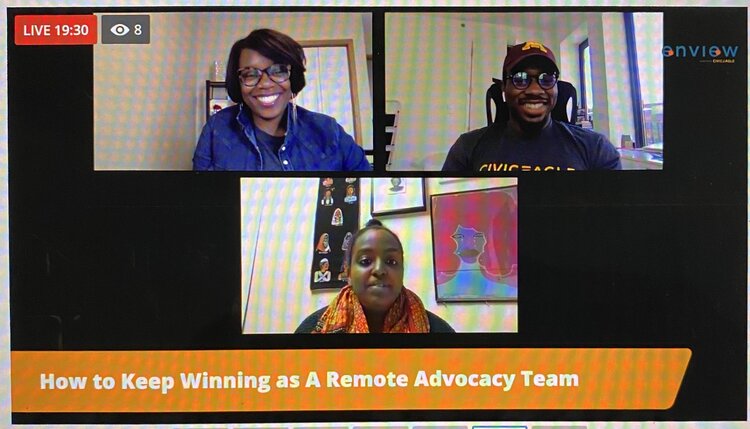COVID-19 has impacted the way advocacy organizations are operating. We spoke with the Executive Director of Minnesota Voice, Wintana Melekin, about how she and her statewide nonprofit are adjusting to the new normal in her industry and adapting to operating remotely. Here are 5 tips for continuing to push your organization forward while working from home.

No. 1— Continue to leverage your ecosystem and network of partners to keep your programs and projects operating.
“Relationships don’t stop just because [of social distancing.]”
— Wintana Melekin; Executive Director, Minnesota Voice
Before coronavirus, Melekin and Minnesota Voice had set a goal to register 72,000 voters in Minnesota in time for the 2020 Elections in November. In order to keep on track of reaching its goals, Melekin is focused on maintaining the relationships within her ecosystem and partnering with groups where she can. For example, she’s leaning into her network by collaborating with the Secretary of State (MN) on a project to set up online voter registration.
No. 2— Build a process for remote work for your organization.
Be careful to assume that your in-person experiences can be simply replicated virtually. You want to recreate a sense of community and team comradery, but accept that there will need to be some adjustments made to your organization’s processes. You can start my researching recommendations and advice from teams that already operate a “remote-first” team culture. Many tech companies have shared blog posts and other content that can help you build your own process for your team. Plural shares their tips here on this blog.
No. 3— Gain buy-in from your team about the new process
This change will be new to everyone in different ways, but transparency is key. Help your team understand what the game plan is and what they can expect in the transition to remote work. Your team wants to know: what’s changed and what’s staying the same?
No. 4— Leverage technology to help you operate.
It’s a good thing that over the past several years new technology has emerged to help organizations conduct business digitally. Many of these software solutions may typically be popular among private sector companies but they can certainly provide value for public sector organizations. Tip: A lot of technology providers offer discounts on their software for nonprofit organizations – email or call them to see if you can get better pricing or extensions on free trials.
No. 5— Don’t forget to have fun.
Now more than ever, your team may need one another for support, encouragement or just to take their mind off of things. Remember to check-in with your team at the beginning of calls, on a personal level. Before coronavirus, those water cooler conversations, coffee breaks and team happy hours were opportunities for teams to connect. Try to reimagine these social experiences digitally — virtual happy hours and cocktail classes; book clubs; movie nights; mid-day coffee breaks.
These tips, and many more insights about remote advocacy, were shared during our webinar How to Keep Winning as a Remote Advocacy Team. You can catch the replay here: https://learn.civiceagle.com/win

Keep track of changes to bills, your notes, files, conversations, and more.
